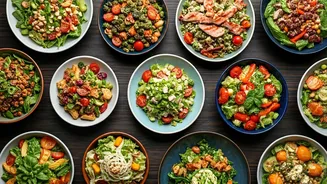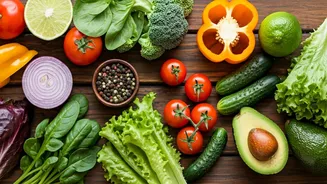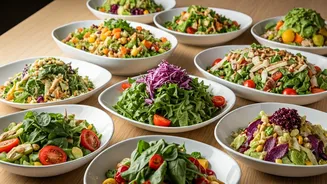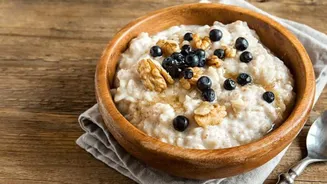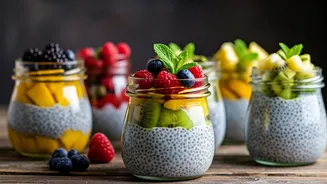Refreshing Green Salads
Green salads are the cornerstone of healthy eating, offering a light yet satisfying meal. Start with a base of crisp lettuce, like romaine or iceberg,
providing a foundation for other ingredients. Add in some cucumbers, which are known for their high water content and refreshing taste. Tomatoes add a burst of sweetness and vibrant color, while bell peppers, especially red and yellow, contribute both sweetness and a delightful crunch. Don’t forget the protein! Grilled chicken or chickpeas are excellent sources. Finally, add a light vinaigrette to tie everything together. The vinaigrette can be customized to your taste. Consider lemon juice and olive oil for a classic option, or experiment with balsamic vinegar or a touch of honey for added complexity. You can also add some herbs such as basil, parsley, and cilantro to enhance the flavor.
Colorful Veggie Combos
Vegetable salads are a fantastic way to incorporate a variety of nutrients into your diet. This section discusses various combinations, such as the classic Greek salad. A Greek salad often consists of tomatoes, cucumbers, red onion, feta cheese, and Kalamata olives, tossed in a simple olive oil and red wine vinegar dressing. Another popular choice is a Caprese salad. The Caprese salad typically features fresh mozzarella, ripe tomatoes, and fresh basil, drizzled with olive oil and a sprinkle of balsamic glaze. For a more exotic option, try an Asian-inspired salad. This may include shredded carrots, cabbage, and a sesame-ginger dressing. Consider adding a protein such as tofu or grilled shrimp to make it a more substantial meal. Using a variety of vegetables in your salads makes sure that you're getting a range of vitamins, minerals, and antioxidants, each vegetable contributing its unique nutritional benefits.
Protein-Packed Creations
Protein salads are a great way to stay full longer. One popular choice is a chicken salad. Chicken salad can be made with shredded or diced chicken, mixed with mayonnaise, celery, and sometimes grapes or nuts. Tuna salad, prepared similarly, offers a good source of omega-3 fatty acids. You can also use chickpeas or lentils as a protein source for vegetarians. For example, a lentil salad, with lentils, chopped vegetables like carrots and celery, and a light vinaigrette, provides fiber and protein. Adding protein to your salad helps to stabilize blood sugar levels, prevents overeating, and supports muscle repair. Think of incorporating hard-boiled eggs for extra protein and creaminess. Or consider a quinoa salad with black beans and corn, which is another protein-rich option that is full of flavor and texture. With these proteins, your salad will give you the energy you need throughout the day.
Fruit-Filled Delights
Fruit salads provide a delicious way to enjoy sweetness and vitamins in one meal. A mixed berry salad, featuring strawberries, blueberries, raspberries, and blackberries, offers antioxidants and fiber. For a tropical twist, make a salad with mangoes, pineapple, and papaya, which are rich in vitamins and enzymes. You can add a sprinkle of coconut flakes for texture and flavor. To balance the sweetness, consider adding a few pieces of feta cheese or a drizzle of balsamic glaze. This combination will make your salad enjoyable. Fruit salads are also incredibly versatile, so you can mix and match different fruits depending on your preferences and the season. They are perfect as a light lunch, a side dish, or a dessert. Experiment with adding ingredients like mint leaves, a squeeze of lime juice, or a dollop of Greek yogurt to enhance the taste and appeal of your fruit salads.
Pasta Salad Extravaganza
Pasta salads are a crowd-pleaser and ideal for potlucks or picnics. Start with your favorite pasta shape. Cook the pasta al dente and let it cool. Then, add a variety of ingredients, such as cherry tomatoes, mozzarella balls, olives, and bell peppers. For the dressing, a simple Italian dressing is always a good choice. You can also make a creamy pasta salad with a mayonnaise-based dressing. This could include ingredients like bacon bits, sweet peas, and cheddar cheese. For a lighter version, try a pesto pasta salad. Combine pesto with pasta and add sun-dried tomatoes, pine nuts, and grilled chicken or shrimp for protein. Consider adding different textures and flavors such as toasted pine nuts for crunch or a splash of lemon juice for acidity. Pasta salads are very adaptable, so use this as an opportunity to be creative and add your favorite ingredients.
Hearty Grain Salads
Grain salads are satisfying, nutritious, and offer a variety of textures. Quinoa, with its complete protein profile, is a great base. Cook quinoa and mix it with chopped vegetables like cucumbers, tomatoes, and herbs like parsley and mint. Season with lemon juice, olive oil, and salt and pepper. Another option is a bulgur salad. Bulgur is a wheat grain that’s quick to cook and great for absorbing flavors. Mix cooked bulgur with diced vegetables, chickpeas, and a tahini dressing. For a more robust salad, use farro, a nutty-flavored grain. Combine farro with roasted vegetables like sweet potatoes and Brussels sprouts, along with some goat cheese and a balsamic glaze. Grain salads are also an excellent way to incorporate beans and lentils for added fiber and protein. They're both filling and beneficial for your health. You can enjoy grain salads warm or cold, making them perfect for meal prepping and taking them on the go.
Creative Dressing Options
The dressing makes a salad! Experiment with different dressing recipes to enhance the flavor. A classic vinaigrette typically includes olive oil, vinegar (balsamic, red wine, or apple cider), a bit of Dijon mustard, salt, and pepper. For a creamier option, try a ranch dressing or a Greek yogurt-based dressing. To make a homemade ranch, mix Greek yogurt with herbs such as dill, chives, and garlic powder. For an Asian-inspired dressing, combine soy sauce, sesame oil, rice vinegar, and a touch of ginger and honey. Adding some creativity with your dressings can transform your salads. Consider making a citrus dressing with orange or grapefruit juice, olive oil, and a bit of honey. Try incorporating avocados into your dressing to create a creamy, healthy base. Dressing also allows you to adjust the flavors of your salad, whether sweet, savory, or tangy.
Seasonal Salad Ideas
Adapt your salad choices to the seasons. In the spring and summer, when fresh produce is abundant, use ingredients such as strawberries, cucumbers, and tomatoes. Add fresh herbs like basil, mint, and parsley. In the fall, embrace ingredients such as apples, pears, and roasted root vegetables like sweet potatoes and carrots. Consider adding nuts like walnuts or pecans, and a maple-cider vinaigrette. During the winter, when fresh greens may be scarce, use kale or spinach as your base. Incorporate ingredients such as oranges and pomegranates. Use hearty ingredients such as roasted Brussels sprouts. Using seasonal produce ensures that you're eating food at its peak flavor and nutritional value. Moreover, seasonal produce helps you to explore a variety of tastes throughout the year. For inspiration, visit farmers markets or explore recipes that highlight seasonal ingredients.
Tips for Salad Success
Several tips can take your salad-making to the next level. Always wash and dry your greens thoroughly to prevent a soggy salad. Use a salad spinner if you have one. Prepare ingredients ahead of time. Chop vegetables, cook grains, and prepare dressings in advance to save time. Dress your salads just before serving to prevent the greens from becoming wilted. If you’re making a salad to take on the go, pack the dressing separately. For added texture and flavor, add toppings such as toasted nuts, seeds, or croutons just before serving. Experiment with different types of lettuce, such as romaine, butter lettuce, or mixed greens. Think about the combinations. Consider adding protein for satiety and flavor. You can adjust your salad ingredients, dressings, and toppings. This will help you find the best way to customize it to your personal preferences and dietary needs.
Salad Meal-Prep Tips
Making salads ahead of time can be a great way to eat healthy and save time. Prepare the ingredients by chopping vegetables, cooking grains, and preparing proteins. Store these components separately in airtight containers in the refrigerator. When you’re ready to eat, assemble the salad by combining the ingredients and adding the dressing. You can also assemble individual salad jars by layering the ingredients to prevent sogginess. Start with the dressing at the bottom. Add the heavier ingredients, such as grains and beans, in the middle. Put the greens on top. This ensures that the dressing does not touch the greens. For the best flavor and texture, add the dressing just before eating. You can pack these jars and take them to work or school. Meal-prepped salads are customizable. With these methods, your healthy salads will stay fresh throughout the week.
